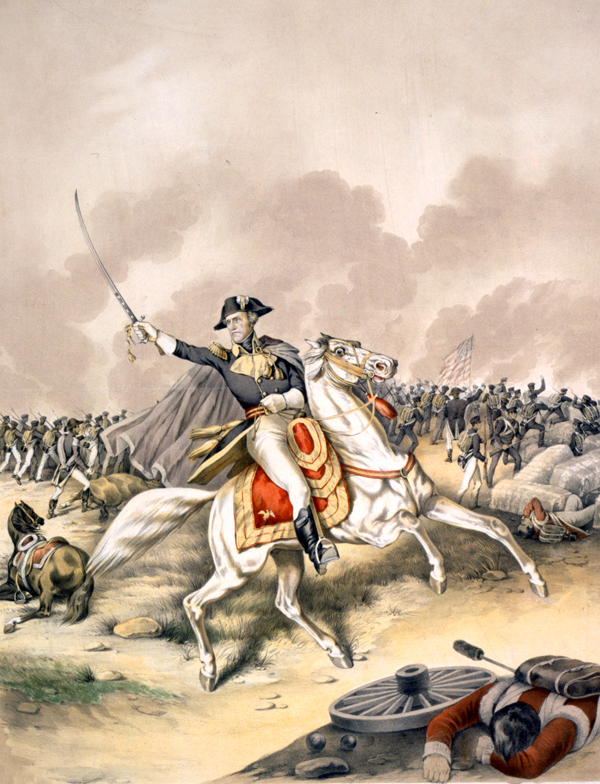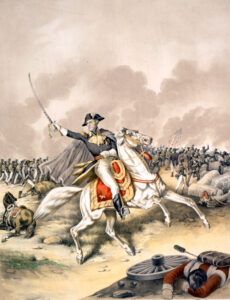Battle of New Orleans
The Battle of New Orleans, the last major conflict in the War of 1812, was fought between British and American forces on January 8, 1815.
This entry is 7th Grade level View Full Entry

Library of Congress Prints and Photographs Division
"General Jackson At the Battle of New Orleans," a lithograph by Charles Severin, 1856.
The Battle of New Orleans, fought on January 8, 1815, was the culmination of a month-long series of skirmishes between US and British forces in southern Louisiana. The battle was the final major engagement of the War of 1812. Despite its name, the battle was fought in Chalmette, five miles south of the New Orleans, in St. Bernard Parish. British forces, led by Major General Edward Pakenham, sought to block the mouth of the Mississippi River, in order to control America’s inland waterways. General Andrew Jackson led the Americans in their attempts to defend the port. Ironically the battle took place after British and American officials had signed a peace treaty ending the war. Though the Treaty of Ghent had been signed on December 24, 1814, the news didn’t reach New Orleans until March.
Why were the British and the Americans fighting?
The Battle of New Orleans was the final major battle of the War of 1812, which began, at least in part, because Americans resented Britain’s domination of the seas, especially British interference with US shipping and the impressment (or forceful recruitment) of sailors from American ships. Some Americans also hoped the war would enable them to grab land in Canada and Florida then held by Britain or its ally, Spain. At the war’s outbreak Great Britain was preoccupied with its war against Napoleon’s France. Victory in Europe in 1814 meant Britain could concentrate on its war with America. The British crown sent twenty thousand troops to invade the United States by way of the Niagara Peninsula, Lake Champlain, the Chesapeake Bay, and New Orleans.
What strategy did Jackson believe the British would use to capture New Orleans?
At first American commanders played down British threats to New Orleans, then a city of about eighteen thousand people. Jackson, who commanded the Seventh Military District (which included Louisiana, the Mississippi Territory, and Tennessee), expected the attack to be made at Mobile, Alabama. Jackson’s prediction proved somewhat accurate. In mid-September British forces did attack Mobile. US troops, however, forced them to withdraw to Pensacola, Florida, a city that then belonged to Spain.
Granted a temporary reprieve, Jackson and his staff relocated to New Orleans to plan their defense strategy. They knew that the British were likely to use one of two water routes in their attack on New Orleans: they could reach the city by sailing up the Mississippi River or by entering Lake Pontchartrain via Lake Borgne. Turns and shallow spots in the Mississippi made the river a less likely route of attack, as did the presence of Forts St. Philip and Bourbon on opposite sides of the river.
What groups made up the fighting force that defended New Orleans, and how did Jackson and Louisianans prepare for the battle?
As Jackson prepared for the attack, his primary concern was the lack of manpower. He had one thousand regular troops and fewer than two thousand militiamen to face twice as many British soldiers. The available American naval force, under Master Commandant Daniel Patterson, consisted of six small, unnamed gunboats; the Louisiana, a more formidable craft without a crew to man it; and the Carolina, a schooner that happened to be in New Orleans.
Ultimately Jackson put together a diverse fighting force that included two divisions of the Louisiana militia, as well as Choctaws, Creeks, African Americans and Afro-Creoles, and Baratarian privateers loosely associated with the brothers Jean and Pierre Laffite. Many Americans questioned the loyalty of French-speaking Louisianans and the wisdom of arming people of African descent with guns.
In December of 1814, a month before the Battle of New Orleans, a British fleet carrying more than ten thousand soldiers anchored in the Gulf of Mexico, not far from Lake Borgne. Unable to take their large ships into the shallow lake, British troops had to load into smaller vessels and then battle the US troops guarding the lake’s entrance. When the two forces met on December 14, the winds, tides, and numbers all worked against the Americans. Within two hours, thousands of British soldiers took command of the lake, came ashore, and began building a garrison on Pea Island, thirty miles east of New Orleans. News of the battle brought panic to New Orleans and rapidly spread through the state. Jackson declared martial law in the city and sent out a call for more men and military supplies.
Spanish fishermen guided two British officers to an unguarded path leading to a plantation owned by Jacques Villeré, major general in the Louisiana militia. Located on the east bank of the Mississippi River, Villeré’s estate put the British within nine miles of New Orleans. Following the same route, British General John Keane and eighteen hundred soldiers surprised the Louisiana militia, commanded by Major Gabriel Villeré, Jacques Villeré’s son, and seized the main plantation house on December 22.
Though Keane didn’t know it, he could have continued up the river road, which was undefended, to within cannon shot of New Orleans. Instead, he waited for reinforcements. That gave Jackson enough time to plan a surprise night attack, using the warship guns of the Carolina and the hastily manned Louisiana for support from the river. He also had his men build defensive earthworks along the Rodriguez Canal, about four miles south of New Orleans. According to historian Wilburt Brown, among others, this decision was “the most decisive single factor in the campaign.” The British suffered an unexpected setback and numerous injuries, while the Americans boosted their morale.
Realizing the Americans wouldn’t surrender easily, Pakenham, the British high commander, arrived at the Villeré plantation on Christmas Day. The next day he ordered an artillery attack on the American ships, both stationed opposite the British camp. The Carolina, becalmed and unable to move, was set afire and sunk by the British. The Americans were able to tow the Louisiana upriver and out of range of British guns.
At dawn on December 28, Pakenham continued the assault, sending two strong columns of troops toward the American line. However, the Americans drove the British back with unexpectedly heavy artillery fire. The British spent the next three days and nights landing heavy naval cannons and bringing up ammunition in preparation for a large-scale attack. British troops came within five hundred yards of the Americans, ready to pounce if the big guns battered a hole in the US fortifications. British guns opened fire at 10 a.m. on New Year’s Day 1815, but the American artillery response drove the British gunners from their weapons after three hours of fighting.
On January 8, Pakenham launched an all-out assault on US troops. A small British force attacked on the west bank of the Mississippi, routing an American force that had been hastily assembled there. The main British attack though was on the earthworks protecting New Orleans on the east bank of the river. Knowing that Jackson’s greatest artillery strength was on the American right, toward the river, the British concentrated on the center and to the left of Jackson’s line.
How did the Battle of New Orleans begin and end?
The attack began in darkness and heavy fog on the morning of January 8, 1815, but the fog lifted as the British neared the American line, exposing the soldiers to heavy fire from US artillery. The British forces, massed in the confined space in front of the earthworks, stood no chance against the musket fire and grapeshot from Jackson’s cannons. When the smoke cleared the Americans surveyed what appeared to be a field of blood; it was, in fact, covered with red-coated British bodies. Most of the senior British officers were killed or wounded. Pakenham had been fatally wounded by grapeshot, leaving General John Lambert to oversee a withdrawal from the battlefield.
Leaving New Orleans presented a challenge to the British army. There weren’t enough boats to carry more than half the men at once. Leaving half an army behind was, the British thought, too much of an invitation to attack. Instead the British spent nine days building a rough road to Lake Borgne. On the night of January 18, the British army silently moved out, leaving campfires burning to mislead the Americans.
The fighting caused more than two thousand British casualties, including 291 dead, 1,262 wounded, and 484 captured or missing. The Americans reported thirteen men killed, thirty-nine wounded, and nineteen missing. After the battle was over, Jackson said, “The unerring hand of providence shielded my men.” The battle enhanced Jackson’s national reputation and eventually helped propel him to the White House. In the bigger picture, historians generally agree that the victory was a catalyst for American nationalism. In the battle Louisianans, who had become US citizens only a few years earlier, proved their loyalty to the nation.
How did the residents of New Orleans react to Jackson? How did their reaction change over time?
Jackson’s popularity in Louisiana fell when he didn’t revoke martial law until March 13, when official word of the peace treaty finally arrived. He was particularly hard on the French Creoles, whom he still distrusted. Feelings became so embittered that the Louisiana legislature refused to include Jackson’s name on a resolution thanking the American troops for their defense of the city. Federal judge Dominick Hall even fined Jackson $1,000 for refusing to end his strict control of the city.
New Orleans eventually forgave Jackson and, in 1851, renamed the Place d’Armes (the large military parade ground in front of the St. Louis Cathedral that is now a public park) as Jackson Square. A dramatic sculpture of Jackson, created by Clark Mills, was installed in the center of the square in 1856. A federal park, now part of the Jean Lafitte National Historical Park and Preserve, was established in 1907 to preserve the Chalmette battlefield.
